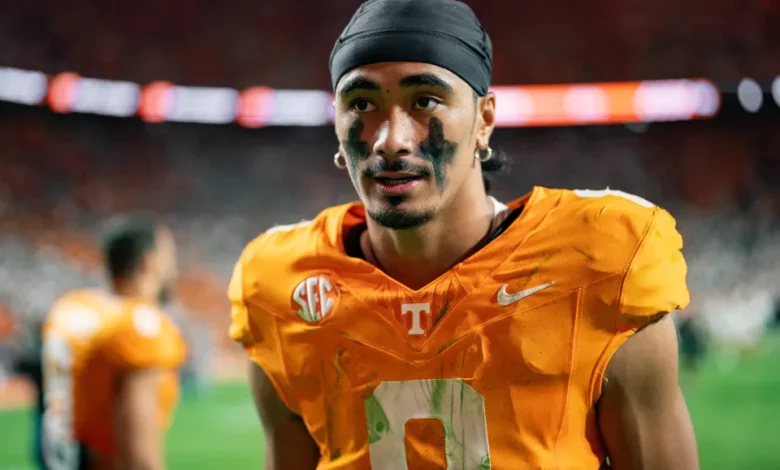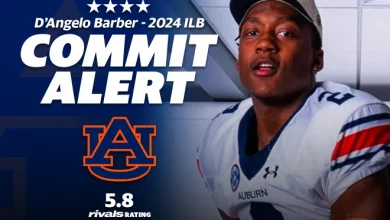‘Waiting for sale’ – Nico Iamaleava suffers transfer disaster as colleges target $1m deal – half his Tennessee contract.

In the high-stakes world of college football recruiting, few players have attracted as much attention, hype, and expectation as Nico Iamaleava. As one of the top quarterback prospects in the country, the California native was widely seen as a future star, capable of leading a college football program to glory. His skills on the field are undeniable, and his potential seemed limitless. But as with many of today’s most highly recruited athletes, the journey to stardom has not been without its roadblocks. In fact, it appears that Iamaleava has recently found himself in the midst of a transfer dilemma that could jeopardize not only his college football future but also his financial future.
In what has been described as a “transfer disaster,” Iamaleava is now reportedly stuck in a limbo of sorts as college programs target a $1 million deal, which would be roughly half of the value of his current contract with the University of Tennessee. This situation has drawn significant attention from both college football experts and fans, especially as the complex new landscape of college athletics – influenced by the introduction of NIL (Name, Image, and Likeness) deals – adds a new layer of uncertainty to the recruiting process. For Iamaleava, this is much more than just a football decision. It’s a business decision that could reshape his future in ways he may not have anticipated.
In this article, we’ll break down the situation surrounding Nico Iamaleava, the financial and recruiting pressures he’s facing, and how his dilemma encapsulates some of the broader changes happening in college football today. From NIL deals to transfer portal complications, this situation sheds light on the complexities of modern college athletics.
1. Who is Nico Iamaleava? A Quick Recap
Before diving deeper into the circumstances surrounding Iamaleava’s current situation, it’s important to recall just who he is and why his transfer decision is so impactful.
Nico Iamaleava is a five-star quarterback prospect who quickly became one of the most sought-after recruits in recent memory. A native of Long Beach, California, Iamaleava displayed exceptional talent throughout his high school career. Standing 6’5″ and weighing around 200 pounds, his combination of size, athleticism, and arm strength made him an ideal quarterback prospect for college programs looking to build a future around a star. His ability to throw deep with precision, as well as his mobility to make plays outside the pocket, drew comparisons to some of the top quarterbacks in recent years.
By the time Iamaleava committed to the University of Tennessee, he was already a household name in college football recruiting circles. His commitment to the Volunteers was a major coup for Tennessee, signaling the program’s intent to return to elite status. Iamaleava was seen as a centerpiece of Tennessee’s offense under head coach Josh Heupel, and fans were thrilled by the prospect of having such a highly ranked player on their roster.
But after some time at Tennessee, it became apparent that Iamaleava’s path would not be as smooth as many had initially hoped. Issues surrounding his role in the program and his future as a starting quarterback started to create tensions, leading him to reconsider his future at Tennessee. With the transfer portal now offering an easy exit for players seeking better opportunities, it wasn’t long before Iamaleava found himself in a much more uncertain situation.
2. The ‘Transfer Disaster’: The Pressure Mounts
The concept of transferring between college programs has always been a part of college athletics, but the introduction of the Transfer Portal and NIL deals has added a new layer of complexity. Today’s athletes are no longer just students and players; they are business entities with contracts, sponsorships, and a brand to maintain. Iamaleava, like many athletes, is learning the hard way that transferring is not always as simple as it seems.
The Transfer Portal: A Double-Edged Sword
The Transfer Portal, which allows players to explore opportunities at other programs without being penalized, has made it easier for athletes to move from one program to another. For Iamaleava, this means he has the freedom to find a new program if he believes his current situation is no longer tenable. However, the Transfer Portal is not without its pitfalls. For one, moving to a new program doesn’t guarantee success. The player must fit into a new system, mesh with a new coaching staff, and acclimate to new teammates. Furthermore, the attention and expectations that come with being a five-star recruit can quickly escalate at a new school, making the transition even more challenging.
In Iamaleava’s case, his move through the portal is complicated by a few critical factors. The first is his current contract with Tennessee, which, according to reports, has a value of approximately $2 million due to NIL and endorsement deals. Should Iamaleava choose to leave the Volunteers, he would have to find a program willing to match that contract – or at least offer something close.
The Financial Dilemma
The financial aspect of this decision is where things start to get tricky. As a highly regarded recruit, Iamaleava was able to secure an NIL deal with Tennessee that made him one of the highest-paid players in the country, even before he had taken a snap for the Volunteers. This deal reportedly includes a $2 million value, which is an unprecedented amount for a college athlete.
However, as Iamaleava considers transferring, it appears that some programs are offering him a much lower sum, with reports indicating that some are targeting a $1 million NIL deal. While this is still a significant amount of money, it is half of what he currently earns at Tennessee. For Iamaleava and his camp, this financial discrepancy raises important questions about whether a move is worth it.
To make matters more complicated, any new program that takes Iamaleava in would need to navigate the complexities of NIL rules, ensuring that the deal complies with NCAA guidelines while also maintaining a competitive advantage. With college football programs struggling to balance their budgets and offer attractive NIL packages, the financial realities of a transfer become more apparent.
The Risk of Loss
If Iamaleava moves forward with a transfer, he risks not only the loss of his current NIL deal but also the potential instability that can come with joining a new program. There are no guarantees that he will secure the same financial deal, or even get the starting job, at another school. For many players, the fear of disrupting their financial situation and football future outweighs the desire to switch programs. And for Iamaleava, the situation is even more precarious as his current contract with Tennessee is tied to both his athletic and market value.
3. Why $1M? The Growing Trend of NIL Deal Discrepancies
The idea that Iamaleava could end up with an offer of $1 million, less than half of his current NIL deal with Tennessee, is indicative of the shifting financial landscape of college football. While NIL deals were initially hailed as a way for athletes to profit from their name, image, and likeness, they have created a fiercely competitive and sometimes unstable market for college athletes.
Many programs are now seeking ways to balance their NIL offerings, which has led to some disparity in what players are being offered. For Iamaleava, the difference between $2 million and $1 million may not seem significant in terms of sheer numbers, but it represents a dramatic shift in how programs value his worth – both as a player and a brand.
Furthermore, the $1 million figure is a reflection of how some programs are adjusting to the new realities of NIL. As more players secure lucrative deals, the pressure on schools to match those deals or offer competitive packages grows. But not all programs are in a position to offer top-tier NIL deals like Tennessee did for Iamaleava. For many programs, even $1 million is a stretch, especially when it comes to funding long-term contracts.
This reality reflects the broader issue in college football today: the growing financial divide between programs that can afford substantial NIL deals and those that cannot. Iamaleava’s situation highlights how even a highly touted recruit like him may face tough decisions about whether to stay with a current program that offers him substantial NIL earnings or move to a program with a smaller, but potentially still lucrative, NIL package.
4. What’s at Stake for Iamaleava?
For Iamaleava, his decision to either transfer or stay at Tennessee is more than just about football – it is a decision that will shape his financial future, his career trajectory, and his public persona. Given the financial uncertainty surrounding NIL deals and the complexities of the Transfer Portal, Iamaleava’s situation is emblematic of the challenges faced by today’s top recruits.
Financial Stability vs. Career Development
While a $1 million offer from another school is still substantial, it comes at a risk. If Iamaleava leaves Tennessee and struggles to adapt to a new system, it could cost him both his starting role and his ability to secure further endorsements. Additionally, the longer-term financial prospects of college athletes in the NIL era are still uncharted territory, making it difficult to predict whether transferring would lead to greater rewards or financial instability.
On the other hand, staying at Tennessee could provide Iamaleava with the stability of a known situation, though it might not offer the same financial windfall. Either way, the stakes are incredibly high.
5. The Bigger Picture: The NIL Era and College Football’s Future
The financial dynamics of college football are changing faster than ever, and Iamaleava’s dilemma is a microcosm of what’s to come in the broader landscape of college athletics. With the rapid growth of NIL deals and the ever-expanding Transfer Portal, the very nature of college sports is shifting. Players like Iamaleava now have to make decisions based not only on their athletic development but also on their financial future and marketability.
This complex new reality poses significant questions for both athletes and schools. How do universities balance the financial aspects of recruiting with the educational and developmental goals of student-athletes? How do programs ensure that they are supporting athletes both on and off the field, especially in an environment where the financial stakes are so high?
The consequences of Iamaleava’s situation will likely extend far beyond his personal career. His decisions and the attention they attract will influence how future recruits navigate the complex intersection of athletics, business, and education in the NIL era.
Nico Iamaleava’s transfer dilemma is a cautionary tale of the challenges faced by today’s elite college football recruits. As the financial landscape of college sports continues to evolve, athletes like Iamaleava will increasingly find themselves caught in a balancing act between their athletic potential, their financial opportunities, and their long-term careers. Whether Iamaleava stays at Tennessee or transfers to another program, his decision will have lasting implications on both his football future and his financial trajectory. As college football enters this new era of NIL, his story is just one example of the complexities that will define the sport moving forward.









